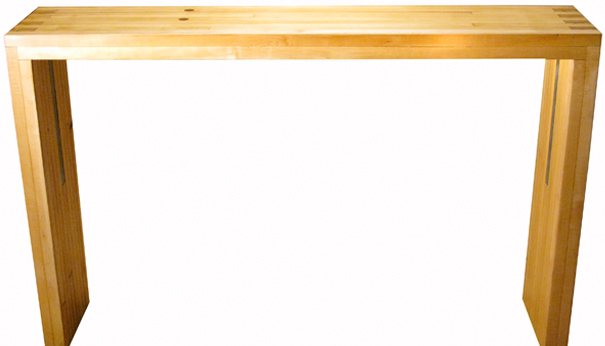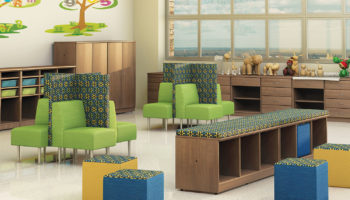Counter Evolution: R/Evolution of the Bowling Alley
As it happens, the gym I go to was once a bowling alley. In order to be as green as possible, the owners reused much of the wood, specifically from the bowling lanes. So, the floor of the yoga room is made completely from pieces of re-purposed wood. The platforms for free weights are also little squares of bowling lane wood. There is even a ramp that leads from the cardio area to the weight area, which is one bowling lane in its entirety. I found this to be an ingenious solution that was also a nod to the old bowling alley–the iconic arrows of darker inlaid wood being my favorite part.
The Brooklyn. Produced by Counter Evolution.
It turns out that many towns and cities and suburbs are ditching the American pastime, bulldozing bowling alleys to make way for other, more modern amenities. This gave Jim Malone, a producer, songwriter, and musician from Manhattan, a great idea: why not re-purpose the bowling alley wood to make furniture? The bowling alley is pure Americana, no matter how you slice it–as American as apple pie. Its retro appeal is a symptom of nostalgia, ranking right up there with vintage gas station jumpsuits and old Vegas neon signs and thrift store bowling club shirts. But in starting Counter Evolution, Mr. Malone bypassed the nostalgic associations of 1950s American life by modernizing the very furniture he designed out of this historically and culturally loaded wood.

The Brooklyn. Produced by Counter Evolution.

The Lilly. Produced by Counter Evolution.
Take The Lilly, for example. A console table of Heart Pine measuring 36″ W x 10″ D x 30″ H, this table features fingerspliced corner joints, exposed endgrain, and Black Walnut dot inlays. The result is a console of mid-century flair–but more Scandinavian simplicity than 50s kitsch. Another great piece produced by Counter Evolution is The Brooklyn, a large table (72″ W x 32″ D x 30″ H) “cut from the ‘dovetail’ section of the lanes.” The table includes a Maple/Heart Pine splice with Black Walnut dart inlays–the aesthetic nod to the wood’s original life. While these darts are a clear reminder of the bowling alley, The Brooklyn tames the association by adding steel I-beam legs. Thankfully, Counter Evolution has thought of practical matters: The Brooklyn “comes with plastic, self-leveling, non-marring black caps to protect floors.” For other great examples of old wood re-adapted for new purposes, see 3rings article “Furniture of a Different Stripe” detailing the designs of Environment Furniture or Uhuru’s #1020 Beam Coffee Table designed by Jason Horvath.
Counter Evolution bills itself as “the premiere source for contemporary Green furniture and eco-conscious commercial installations made exclusively from wood reclaimed from bowling alleys.” This is certainly enough to garner interest in the company’s products. However, the furniture itself is well-designed, with just enough of a nod to the American icon of the 1950s to make the pieces allude to a bygone era without letting the wood’s original purpose overpower the furniture. The darts and dots and inlays are integrated into the furniture’s design with both purpose and subtlety.
via CoolHunting




Leave a Reply